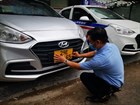Circular 63: Site inspection of traffic accidents by Traffic Police
This is a noteworthy provision in Circular 63/2020/TT-BCA stipulating the procedures for investigating and resolving road traffic accidents by the Traffic Police force, which takes effect from January 01, 2021.

Circular 63: Scene examination with traffic accidents conducted by the Traffic Police (illustrative image)
Article 9 Circular 63/2020/TT-BCA provides regulations on scene examination for traffic accidents conducted by the traffic police, as detailed below:
The examination of traffic accident scenes where there are consequences such as: a person dead at the scene, dying on the way to the hospital, or dying during treatment; individuals with severe injuries such as crushed or severed limbs, blindness in both eyes; skull fractures; three or more injured people with broken arms or legs, or property damage estimated at 100 million VND or more, shall be conducted in accordance with the criminal procedure law.
For traffic accidents without any of the above-mentioned consequences, the examination procedures are as follows:
1. Actions prior to scene examination:
- Receive tasks from the scene protection unit;- Determine the scope of the scene; location of victims, evidence, vehicles, and traces; ascertain whether the scene is intact or disturbed. Use a camera provided to the traffic police to record the entire scene before examination;- Identify examination components;- Assign tasks to participating members;- Choose examination method; determine the appropriate direction for examination; identify reference points, the reference edge of the road to locate victims, evidence, vehicles, and traces. The reference point must be durable over time, easily recognizable, and convenient for measuring and sketching the scene;- Prepare technical equipment and tools for the scene examination.
2. Conducting the examination:
Specific procedures for examining the scene:
- Observe the entire area where the traffic accident occurred to determine the position of victims, evidence, vehicles, and traces related to the traffic accident at the scene;- Based on the examination direction and reference points at the scene, mark the position of all victims, evidence, vehicles, and related traces in natural order;- Photograph the scene including: common scene photos, partial scene photos, video recordings (if any); take photos of victims, evidence, vehicles, and related traces with a scale ruler. Scene photos must be compiled into a Scene Photo Report, ordered, and annotated;- Measure and sketch the traffic accident scene: Standardize symbols and measurement units; fully represent the traffic organization (signs, road markings, roundabouts, traffic lights, and related signaling systems) at the accident site; annotations must show the drawing scale, traces, and symbols on the scene sketch;- Collect evidence, vehicles, and traces for preservation and sampling in accordance with the law. Easily changeable or deformable traces must be immediately collected and preserved, such as blood stains, hair, fibers, gasoline, oil, and other organic chemical traces.
Note: When examining the scene, a Scene Examination Record and a Sketch of the Traffic Accident Scene must be made, which must be consistent with the Scene Examination Record.
3. Making the Scene Examination Record
The content of the examination record must include the start and end time of the examination, location, members participating in the examination; conditions of the scene before the examination, weather, and light conditions during the examination, and the examination process, as follows:
- Describe the general scene such as: The location of the accident on a one-way or two-way road; the type of divider; road width, shoulder width; signaling system; type of barriers or guardrails; obstacles on the road; road characteristics and shape (flat or sloping, straight or curved, obscured or not); road surface type (concrete, asphalt, gravel, or dirt); condition of the road surface (flat, smooth, cracked, or slippery);- Record the numbering of the positions of victims, evidence, vehicles, and traces;- Record the determination of reference points, road edge references, and scene examination direction;- Describe the location and characteristics of victims, evidence, vehicles, and traces at the scene according to the numbering;- Specify the quantity of evidence, vehicles, and traces discovered, collected, and preserved, and the comparison samples;- Record the use of specialized electronic equipment for modeling to measure victim positions, evidence, vehicles, and traces at the scene, draw the scene or take scene photos, and video recordings (if any).
4. Conclusion of the scene examination:
- Review the tasks performed during the examination;- Evaluate the traces and documents collected at the scene to determine their relevance or the need to collect additional traces;- Approve and sign the scene examination record and the traffic accident scene sketch.
Note: After the scene examination, the traffic police officer assigned to investigate, verify, and handle the traffic accident must submit a Report on the results of the traffic accident scene examination according to form no. 07/TNDB issued under this Circular and propose further investigation, verification, and resolution measures.
Details can be found in Circular 63/2020/TT-BCA, effective from January 01, 2021.
Ty Na
- Procedures for commendation of individuals with achievements in militia and self-defense forces in Vietnam
- Determination of asset valuation costs in civil proceedings and administrative proceedings in Vietnam from July 1, 2025
- Procedures for commendation of collectives with achievements in militia and self-defense forces in Vietnam
- Formula for calculating severance policy for officials during organizational apparatus in Vietnam
- Content of statistical reporting policies in the planning and investment sector in Vietnam from April 1, 2025
- Cases exempt from advance payment of on-site inspection and assessment costs in civil proceedings in Vietnam from July 1, 2025
-

- Procedures for commendation of individuals with ...
- 09:30, 23/01/2025
-

- Promulgation of technical regulations on the system ...
- 17:42, 22/01/2025
-

- Latest guidelines on electing delegates for the ...
- 17:40, 22/01/2025
-

- 17 propaganda slogans celebrating the 95th anniversary ...
- 17:30, 22/01/2025
-

- Regulations on the professional title codes for ...
- 16:52, 22/01/2025
 Article table of contents
Article table of contents
